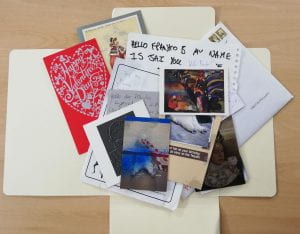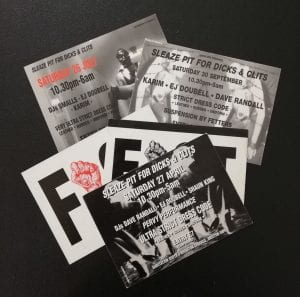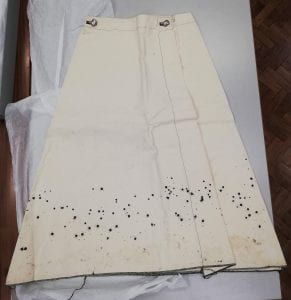As part of the Wellcome Trust funded project Challenging Archives: Delivering research access, public engagement and the curatorial care of the Franko B archive, writers-in-residence Mary Paterson and Maddy Costa are engaging creatively with the Franko B archive as it is catalogued, conserved and made accessible. This is the fourth in a series of blog posts reflecting on the complex set of challenges the Franko B archive poses, the archival process, and the ways in which the archive might inspire new creative work. Franko B’s artistic practice explores issues such as the limits of the body and the human condition, dealing with pain, suffering, abuse of power, empathy, eroticism, and sexuality in contemporary culture.
In their most recent posts, Maddy and Mary have posed each other a series of questions, on the subject of encounter and engagement with archives, and with Franko B’s archive specifically. The dialogue begins here, continues here, and concludes with this post, in which Mary asks the questions and Maddy replies.
You studied English at University. What does the study of literature have to teach us about how to approach the archives of Live Art?
An instinct to avoid the question.
This is personal. Those years at university were a privilege that clings through every attempt at erasure. Worn on the body like a skin, like an armour, no matter how fragile the matter beneath. And so ill-fitting. Three years of avoiding study, spending hours in second-hand bookshops bingeing on the idea of books but not actually reading them, or running away, to gigs, to London, to New England once, following a band, to the loss of self only music could bring. No lectures. Finishing essays at 6am. Three years of block and avoidance. At least back then it was free.
But also:
Discovering Gertrude Stein. Discovering Djuna Barnes. Discovering the feminist writers of the 1890s, and the queer culture tucked in the pages of The Yellow Book. Discovering French feminism, Hélène Cixous, Luce Irigaray. Adding these things to riot grrrl fanzines and queercore bands and the deaths of River Phoenix and Kurt Cobain. Discovering Pauline Boty. Discovering Shostakovich. One magical month learning how to spin a web from myriad threads, connecting things seemingly unrelated. A skill that would finally find its uses in the encounter with performance and live art.
But also:
Feeling overwhelmed. Feeling unable to fathom the depths of language, only ever swimming in the shallows of a poem. Feeling the tools of criticism weigh heavy, mistaking a sledgehammer for a scalpel. Feeling at the edges of nuance but finding no way in. Perhaps everyone feels this gut-punch of fraudulence, this itch of imposter syndrome.
Too many critics of performance arrive from the study of literature, unversed in the lexicon of the body, seeking the fixed and the focused. The archives of live art avoid definition but might be described as places of vagary, fallibility, refusal. Here the ephemeral becomes tangible but still evasive, present but still absent, comprehensive but still incomplete. The text is partial, the subtext elusive. Perhaps it’s not the study of words themselves that teaches us how to approach the archives of live art but the study of the space between the words and between the lines.
But also:
The study of literature never ends. A journey literal and lateral, criss-crossing a landscape wide and deep. Always receptive, always discovering, always leading to other fields – philosophy, politics, performance of course. Live art is all of these. The fences between each field open like the margins of a page.
What is the cultural landscape that Franko’s archive imagines? What is it for you?
What is it to step into a landscape long avoided? Perhaps even, just a little bit, feared?
I am sitting in a hospital room having a cannula inserted into my arm, similar to the kind Franko uses for his blood-letting performances. The nurse tries a vein in my left arm, and then in my right, a vein in my left hand and then in my right. Each time a scratch, a scant dash of blood, and then the vein slips away. After five attempts I am nauseous with anxiety and almost faint. This is the landscape I imagined when I thought about Franko’s work. Even though the blood-letting performances are only a fraction of that work.
The archive requires a reimagining on my part. Or rather, has offered a remembering.
I remember a pub in Essex Road, a frayed artery of north London, called Disgraceland. Opening a newspaper to see a photo of it used to illustrate an article on social inequality in the landscape of my youth, wealthy people oblivious to the fractured lives of their near-neighbours in homes judged unfit for human habitation. The name of the pub was ironic and true.
I remember walking the underpass at Waterloo station, known then as cardboard city, a home claimed and created by homeless people.
I remember Soho’s reputation as a dive bar at 3am exploded across tight-knit streets. Sex workers louche in doorways and gay men holding hands and neon lights and detritus and defiance ingrained in the tarmac.
I remember a photo of Derek Jarman on a hospital bed, dying, bringing up the death toll of AIDS, surrounded by cherubic young men. The friend holding the book pointing out his younger self in the photo, fresh-faced, luminous.
I remember a girl at school knocking the heel from her shoe to show the cavity where she hid Ecstasy pills on the nights she slipped out raving.
This is the cultural landscape of my growing up, most of it, just a little bit, feared. Even then it was being swept aside and the landscape that’s replaced it – metal shard and mirror glass, locked door and security guard – is so much more terrifying. What’s that thing Franko says? “Once I was underground, now I’m marginalised – it’s a big difference.”
His archive is that difference.
Maddy: who else needs to know about this archive? Who else needs to breathe this air, construct this landscape, be vulnerable here?
I hold the past in the palm of my hand. I hold the present, I hold the world. I swipe, navigate, like, share. I find Franko’s website, see photographs of the work, read lists of dates, read reviews. It’s comprehensive. Ordered, orderly, aligned with precision. Even the bulges of his naked body are minimised by this geometry of containment.
There is a line in Mark Fisher’s book Capitalist Realism that haunts me: “Capitalism seamlessly occupies the horizons of the thinkable.” Website design portions the thinkable into neat boxes, regimented fonts, formats that function equally across desktop and mobile. What might be beyond the horizon?
I have watched the archive in its journey from slapdash miscellany of plastic containers to the standardised boxes and folders of a library collection. Each item finding its place in a catalogue, sequenced, numbered, filed. But this feels like a different kind of order: one that sets disobedience free. Open a folder the colour of farmhouse butter and what surprise might slip out? My favourites so far: a diary, hand-scrawled with messages mundane and mysterious; a sequence of flyers advertising a fetish club night (“sleaze pit for dicks & clits”) with an escalating intensity of dress code, first strict, then ultra strict, then very ultra strict; an angular skirt constructed with the canvas from one of the bleeding pieces, splattered with blood, sullied with mud, reshaped with lines of stitching that skitter across the heavy fabric. Each object holds the fingerprint of those who’ve held it before, trace of long-shed skin cells.
The archive is for those who hold the world in the palm of their hand and know there are further horizons. Already, two or more decades ago, predating so much modern technology, capitalism had shaped a generation (to quote Fisher again) “whose every move was anticipated, tracked, bought and sold before it had even happened”. Algorithms track and anticipate and hustle the seeker down predetermined paths. The archive is for those who crave a different map of discovery.
Maddy – my final question to you: amongst this multiplicity of angles, where are you coming from?
from the ego that (still) wants to make art
from the humiliation of (repeatedly) being the least creative person in the room
from the desire to work with and for others, alongside and through others, to think in conversation, to write in collaboration, to be part of something bigger than myself
from a belief in stories handed on, handed down, retold, reshaped, forged myths, unblinking testimonies, cult romances, besotted critiques
from love of words, love of people, love of mystery, love of otherness, love of dogs and sometimes children
from queer idolatry and feminist passion
from curiosity, doubt, fear
from two conflicting impulses: to be visible/heard/known, and to slip through a crack, disappear



